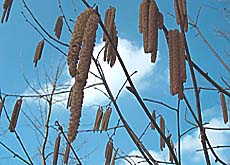Spring fever is in the air

For over a million Swiss, the first days of fine weather are not associated with the joys of spring, as wind-borne pollen triggers hay fever, asthma attacks and skin rashes.
And the situation could get worse. Specialists warn that climate change could lead to year-round pollinosis (pollen-related allergic reactions).
The statistics speak for themselves: pollinosis affects more than one million people in Switzerland – between 15 and 20 per cent of the population.
And where allergies generally are concerned, the situation is even more worrying.
Two major national epidemiological studies have revealed that between 30 and 40 per cent of the Swiss population can be regarded as atopic. In other words, more than two million people have a hereditary predisposition to allergies.
Allergic reaction
As in most other countries, the main cause of allergic reactions is wind-borne pollen.
And, as elsewhere, the number of allergy sufferers has shown a steady increase, from one person in a hundred in 1926 to something like one in seven today.
According to Brunello Wüthrich, professor emeritus at the University of Zurich, there are many reasons for the increase.
“In the case of atopic children, who have a genetic predisposition to allergies, the first allergies to manifest themselves are food-related, due to the intake of foreign proteins when the child is weaned.”
Normally, these allergies disappear when the child is still very young, but they are replaced by other disorders, such as conjunctivitis and rhinitis, caused by the presence of household allergens such as pet fur, dust mites and mould spores.
Bad air
Cigarette smoke and air pollution also have harmful effects: they may cause inflammation of the respiratory system and so facilitate the access of external allergens, such as pollen.
Then there are risk factors determined by social and economic variables.
“For example,” explains Wüthrich, “in the wealthier social classes, we find relatively more cases of dermatitis and hay fever.
On the other hand, the more children there are in a family, the less likely they are to suffer from allergies.”
And these are not the only factors involved. According to the experts, our “Western” lifestyle – the accelerating pace of life, stress, the increase in road traffic, new eating habits – may be contributing to the increase in allergies.
Pollinosis round-the-clock
One of the factors contributing to the increase in pollen-related allergic reactions is the greenhouse effect, which has caused average temperatures to rise by as much as 1.5 degrees Celsius over the last 30 years.
This has resulted in some allergenic plants, such as hazel, flowering earlier each year.
“In Zurich in 1969, the earliest recorded date for the flowering of hazel was 17 March; while just over 30 years later the same plant flowered on February 2,” reveals Wüthrich.
Alder and birch – other species much feared by allergy sufferers – also flower a fortnight or so earlier than three decades ago.
Therefore, not only do allergies manifest themselves earlier, but the pollen is more abundant.
“Four to six times more abundant in the case of alder,” confirms the specialist. “And if things continue at this rate, pollinosis will be prevalent all the year round in Zurich, as it is already south of the Alps.”
Diesel menace
As well as rising temperatures, there is another factor which has a direct influence on allergies: pollution, especially pollution from diesel engines.
Particulate emissions have what is known as an adjuvant effect. In other words, they increase the allergy-triggering effect of pollen on patients who already have a tendency to manifest allergic reactions. The consequences are all too predictable.
“For this reason,” adds Wüthrich, “I have always advised against the large-scale adoption of diesel engines, which would constitute an additional major risk factor for allergy sufferers.”
swissinfo, Fabio Mariani
The pollen season begins in Switzerland with the flowering of the hazel and the alder in January and February. South of the Alps, it may begin as early as December.
This is followed in March and April by the shedding of pollen from two other allergenic trees: the birch – which causes respiratory allergies in 8% of Swiss people – and the ash.
Grasses, which cause the condition popularly known as “hay fever” in 12% of the population, produce their pollen between May and July.
Other very allergenic plants flower from July to September, depending on the region. These include artemisia and the notorious ambrosia, which is fortunately not very widespread in Switzerland.
Today in Switzerland, one person in seven suffers from pollinosis (pollen-related allergic reactions).
In 1958 the figure was one in twenty, and in 1926 less than one in a hundred.
One-third of the population is atopic; in other words, they have a genetic predisposition to allergies.

In compliance with the JTI standards
More: SWI swissinfo.ch certified by the Journalism Trust Initiative


You can find an overview of ongoing debates with our journalists here . Please join us!
If you want to start a conversation about a topic raised in this article or want to report factual errors, email us at english@swissinfo.ch.